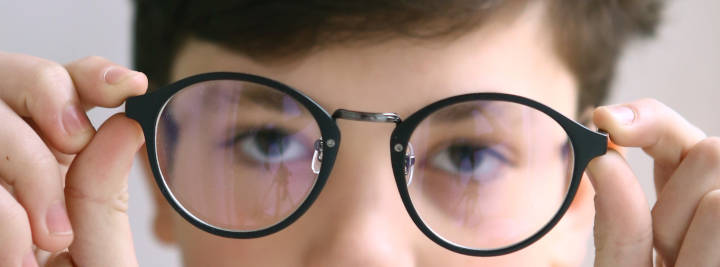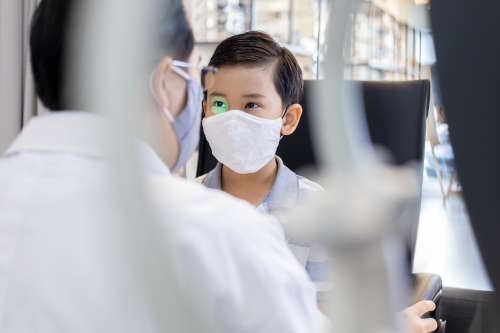

 by
Mamisoa Andriantafika
by
Mamisoa Andriantafika
The results of a recent clinical trial confirm that atropine is an effective medication for slowing down myopia progression in children aged 6 to 12.
Over the course of three years of study, it has been demonstrated that daily administration of low-dose atropine eye drops in each eye was more effective than a placebo. This treatment has shown promising results in terms of reducing changes in glasses prescription and inhibiting eye elongation in children aged 6 to 10 with myopia.
Eye elongation is responsible for the development of myopia, also known as nearsightedness, which typically manifests in childhood and tends to worsen during adolescence before stabilizing in most individuals. Besides the need for ongoing visual correction, myopia presents an increased risk of various eye conditions later in life, including retinal detachment, macular degeneration, cataracts, and glaucoma.
"The idea of keeping the eyes smaller is not just for thinner glasses, but also to avoid these associated complications. It's an exciting work for the myopia research community, which I've been part of for 35 years. We've been talking about treatment and control for decades," said Karla Zadnik, lead author of the study, professor, and dean at The Ohio State University College of Optometry.
The results of the Childhood Atropine for Myopia Progression (CHAMP) trial were published in JAMA Ophthalmology on June 1, 2023.

The CHAMP study is a randomized double-blind study.
Approximately one-third of the global adult population is affected by myopia, and it is projected that the worldwide prevalence of myopia will reach 50% by 2050. While a contact lens approved by federal authorities exists to slow down myopia progression, no pharmaceutical product has received approval for myopia treatment in the United States or Europe.
Several years ago, animal studies hinted at atropine's potential to slow down eye growth. However, the use of full-strength atropine posed challenges due to its impact on near vision and concerns about pupil dilation, which hindered its initial exploration as a potential treatment for myopia in humans. Recent research has indicated that low-dose atropine may be promising.
In this recently conducted phase 3 trial, which was double-blind and randomized, the efficacy and safety of two low-dose solutions were evaluated. The concentrations of atropine used were 0.01% or 0.02% compared to a placebo. The 489 children aged 6 to 10 who participated in the study received one drop per eye every evening at bedtime. This dosing approach aimed to minimize any blurring effect on vision caused by atropine, thereby reducing disruptions during the evaluation of its effectiveness.
The researchers found that the solution containing 0.01% atropine yielded the most remarkable improvements at all time points compared to the placebo, which was slightly surprising. Although the 0.02% atropine formulation also demonstrated better efficacy in slowing down myopia progression compared to the placebo, the results were less consistent in comparison.
"The story for 0.01% is clearer and more evident in terms of significant slowing down of both eye growth and achieving a lower glasses prescription," said Zadnik.
The safety of the medication was evaluated in a larger sample of 573 participants, including children aged 3 and older up to 16 years. Both low-dose formulations were found to be safe and well-tolerated. The most commonly reported side effects were light sensitivity, allergic conjunctivitis, eye irritation, pupil dilation, and blurred vision, although these side effects were infrequent.
The CHAMP trial marks an important milestone as the first study of low-dose atropine to incorporate placebo control groups over a three-year period. Additionally, it involved a large and diverse population recruited from 26 clinical sites in North America and five European countries. In a later phase of the trial, researchers are currently examining eye response after the end of treatment.
The experimental medication is formulated without preservatives and, if approved by federal authorities as a therapeutic option, would be distributed in single-use packaging to ensure convenience and reduce the risk of contamination. The researchers noted that the currently available low-dose atropine, which can be obtained from compounding pharmacies, may contain preservatives that have the potential to cause dry eyes and corneal irritation.
Approximately one-third of the global adult population is affected by myopia, and it is projected that the worldwide prevalence of myopia will reach 50% by 2050.
The slowing down strategy differs depending on the situation.
Young children are most often hyperopic, meaning their eyes are smaller than normal. They can often compensate for vision because they have a strong focusing ability. With age, the eyes grow and eventually reach normal size by the end of adolescence.
However, if they are myopic, meaning their eyes are larger than normal, accommodation cannot compensate. The eyes will continue to grow, and therefore myopia will continue to increase. Eye elongation can continue after puberty, often later if myopia is more than 6 diopters.
The first approach is prevention: the child should maintain a minimum distance for reading and screen time and should prioritize outdoor activities.
The strategy is to act fairly quickly when significant myopia for age is observed: a myopic 5-year-old child will be treated differently than a 12-year-old, but also if the rate of myopia progression and/or eye axial length increase is rapid.
The "myopia" protocol is applied to any myopic child below 9 years old or to any significant myopia progression below 15 years old. It involves performing cycloplegia: eye drops are instilled to block accommodation in order to precisely evaluate the degree of myopia. We also measure the axial length of the eye using Lenstar and Anterion devices.
This protocol is performed every 6 months to establish curves similar to growth charts for height or weight. Depending on the progression, the treatment will utilize clinically proven methods: the use of 0.01% atropine and/or myopia control glasses. We do not use overnight lenses or orthokeratology.
We have been using a "myopia" protocol since 2020.